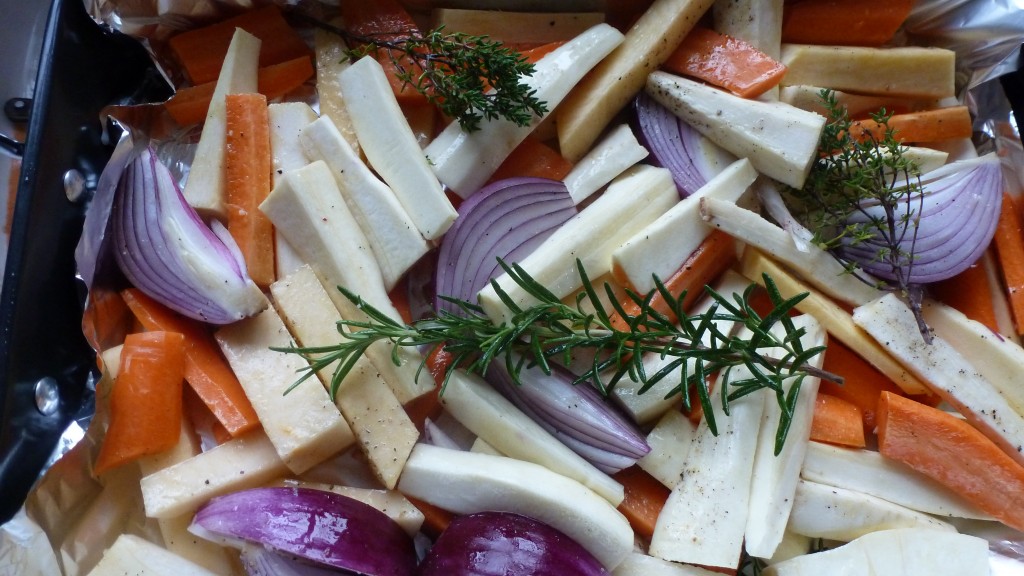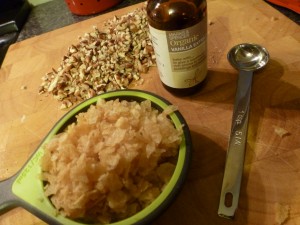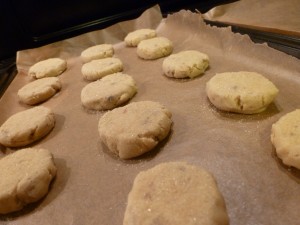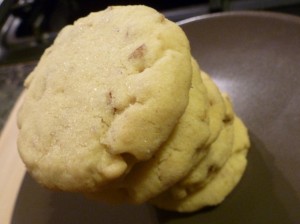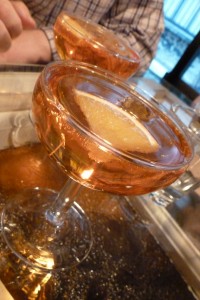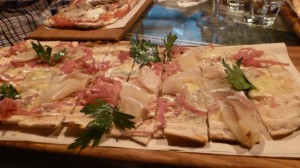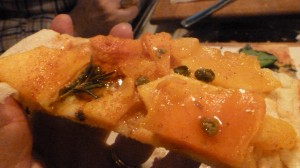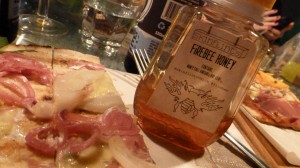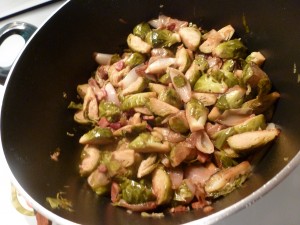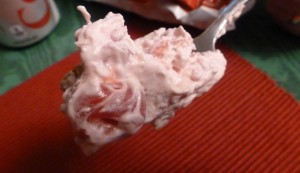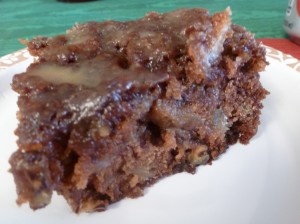Looking through all the pics from Christmas. So much good eating: a lovely ham cooked in Cidona a la Catherine Cleary (with Highbank Orchard Syrup), plates of Christmas cookies, spiced beef and spiced pies and spiced beer. But this is my favorite picture. I don’t even like most of the veg in this pan, but they look so lovely and simply perfect, putting on their Christmas best.
Food Bloggers Holiday Cookie Exchange
This year the Irish Food Bloggers Association organized a holiday cookie recipe exchange. Bill and I love baking Christmas cookies, so I eagerly signed up. I was paired in the recipe exchange with Evin from Evin’s Cooking Peas & Q’s. Turns out Evin is a fellow American, so knows a cookie from a biscuit. And her recipe uses US measurements which is handy enough for me.
Evin sent me a recipe for one of her friend’s cookie traditions. First thing you’ll notice about the recipe is that it contains potato chips. Then you might wonder who Gladys Lum Bower is.
These cookies go together very easily. This is a flexible recipe; I used twice as many pecans for the heck of it, and the cookies turned out great. I used golden caster sugar and Kettle Chips potato chips. I’m not sure we would have identified the potato chips if we didn’t already know they were there, but the chips do add an extra bit of crunch. These cookies have a nice crumble and taste of butter and pecans. They are similar to a pecan sandie, which is great because I like pecan sandies.
I don’t know who Gladys is, but she makes a fine cookie.
Gladys Lum Bowers’s Pecan Crunch Cookies
1 cup butter, softened (of course) [225 g]
1/2 cup sugar [100 g]
1 tsp vanilla [5 ml]
1/2 cup finely crushed plain potato chips [?? g]
1/2 cup chopped pecans [50 g]
2 cup flour [240 g]
See Evin’s take on my recipe from the swap: Frosted Oatmeal Cookies.
A Pizza Feast
Today Bill and I dined at Skinflint with some fellow food bloggers and had the opportunity to chat with its proprietor Joe Macken, and I’ll tell you, he charmed my culinary socks off.
Joe’s well known in Dublin eating circles as owner of beloved Jo’Burger and its sister droolstaurant Crackbird. He’s got memorable hair and has probably been described as “larger than life.” Dublin is lucky to have him. Because Dublin is lucky to have his food. I’ve been to Jo’Burger only once. It’s just not in my orbit, but I remember being quite happy with my burger, which doesn’t always happen in Dublin. We’ve visited Crackbird a number of times, and were very impressed, even when it was just a fleeting pop up.
I said then that “Crackbird is quirky, but it’s the kind of quirkiness that lives in service, ultimately, to the food (along with admittedly some self-knowing hipness)….“ And that’s what struck me when talking to Joe today. He’s mad creative and his persona is definitely present in his restaurants, but foremost Joe loves his food. And he makes other people love it too.
We started our lunch with Aperol cocktails, as you do, followed by a trio of bread and dips:Â brandy chicken pate, beetroot caviar, and hummus. The pink peppercorns in the pate bring an aromatic note to the richness of the liver. The beetroot caviar was a lovely balance of sweet and savory, and is a gorgeous jewel red. The hummus was garlicky, which is how we like it!
Then we ordered our pizzas. We ordered almost every pizza. There are 10 set pizzas on the menu, each named after the mother of a staff member. One of our party went for the daily meatballs, which today were lamb. (Check twitter for the daily meatball.) I ordered the Lil which is Boyne Valley blue, poached pear, sweet pickled onion and cream. Yeah. Bill chose the Tess with pulled pork, fennel seeds, braised fennel and marscapone. The table also saw some amazing combinations like roasted garlic confit, toasted hazelnuts, tomato, Fontina and spinach & butternut squash, rosemary, ricotta, capers and espelette.
The pizzas at Skinflint are grilled, which is a great method to create a thin crackery crust (reminded me of crust on a pizza we had Rome). Joe invited us in pairs into the compact kitchen to watch the lads prepare the crusts, which are made with 100% Odlums flour fermented for three days, then run through a cool machine from Italy that stretches out the dough, and coated with some semolina. Then the dough goes onto the grill and is dressed with its toppings, and after a minute or two is ready for serving. A quick enterprise which is good for hungry diners and kitchen throughput alike.
I recommend going to Skinflint with six to eight friends so you can taste all the pizzas. It was hard to pick a favorite. I was almost overwhelmed by all the amazing flavors on our table. I’ll say braised fennel stands out as a genius pizza topping, and Bill was quite taken with the butternut squash and caper combo. My pizza was a perfect celebration of the love between pear and blue cheese, and Joe is proud to be using Boyne Valley blue which is a goats cheese blue. A stronger blue, but right at home on that pizza. I also liked the housemade Mexican chorizo, and roasted garlic is another brilliant pizza topping. Pizza is all about bringing flavors together to create greater-than-the-sum-of-its-parts-Super Flavor, and these pizzas are super. Especially drizzled with Skinflint’s Firebee honey infused with chile. Seriously, this honey should be given out to school children to teach them about the good things in life. No wait, perhaps it should be a reward for becoming an adult. Either way, it’s great.
Skinflint and Crackbird are filling a much needed place in Dublin–casual, excellent food that has an identity. Joe is committed to making Irish food with Irish ingredients and he’s no where near stopping, and we couldn’t be happier.
And as always, great fun to dine with fellow bloggers Aoife from I Can Has Cook, Aoife from The Daily Spud, and Catherine from The Runcible Spoon, and we had some handsome partners along as well.
Bill and I were thrilled to finally try A Winter’s Ale from 8 Degrees Brewing. This delicious, lightly spiced ale was perfect with our pizza.
Mucho thanks to Joe and staff for a terrific time.
Home for Thanksgiving
This year we were home for Thanksgiving. Home in this instance was Bill’s childhood home in Huntsville, Alabama.
We typically have two must-eats when we’re in Huntsville: Pork BBQ from Gibson’s #2 and fried catfish and hush puppies at Greenbrier. We knew we didn’t have time for a trip to Greenbrier this visit, but Bill’s mom, Peggy, said she’d have Gibson’s BBQ waiting for us when we arrived Wednesday evening. When Bill’s brother Joel heard about the Gibson’s plan, he had a better idea. I’ll smoke a pork butt for them, he said. Only one problem. Joel lives three hours away in Montgomery and wouldn’t be driving to Huntsville until Thursday. So, Joel overnighted the pork on dry-ice to Peggy’s and indeed it was waiting for us when we arrived. And it was truly remarkable. Pork BBQ in Northern Alabama is typically eaten with a vinegar and cayenne pepper sauce alongside a vinegar slaw. Joel had included sauce in his package, and Bill’s other brother Danny had brought over a bowl of slaw, so Bill and I feasted! Sorry Gibson’s, but I’m dining at Gunter’s from now all. All those Gunter boys can cook!
Not only did Joel smoke the best pork BBQ I have eaten, he smoked our Thanksgiving turkey. He brined the turkey with apple juice, orange juice, nutmeg, ground cloves, peppercorns, brown sugar, and kosher salt and smoked it over fruit wood for a few hours, finishing it in the oven. The turkey was perfect–moist, flavorful with tasty skin. He also brought up some of his lovely homebrew, a summer ale with honey and a hint of orange. It was sunny and 74°F/23.3°C, which passes for a summer day in Ireland, so summer ale was not out of place.
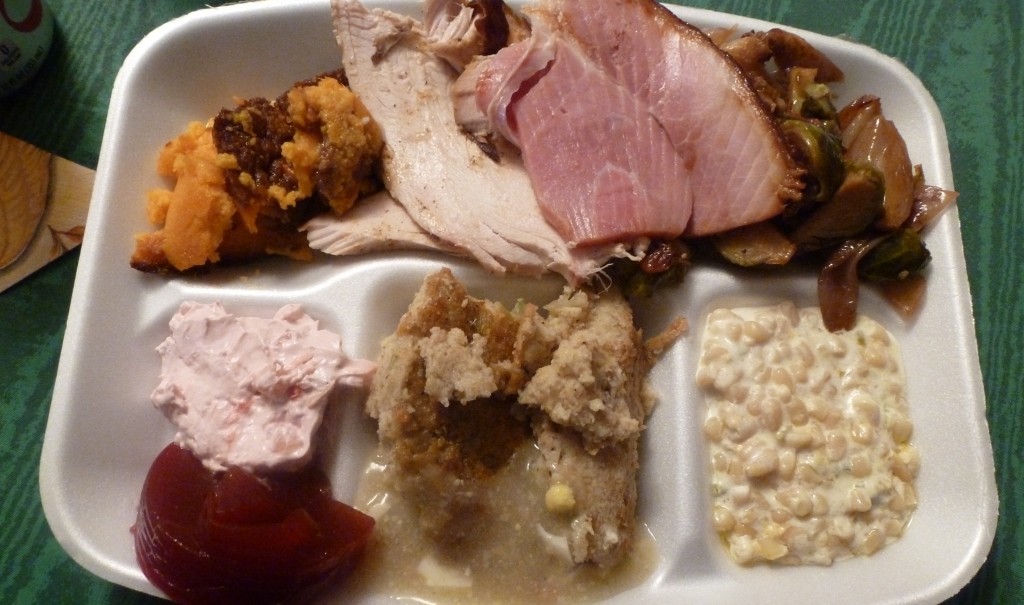
The Meal (clockwise from top left): Sweet Potato casserole, turkey, ham, Brussels sprouts with pancetta, jalapeno corn casserole, cornbread dressing with gravy, jellied cranberry sauce, cherry fluff; not pictured: field peas, dessert
I haven’t traveled all the regions of the US eating Thanksgiving dinners, but I imagine two things identify our Thanksgiving meal as Southern: 1) more than one casserole and 2) cornbread dressing. First of all, we call it dressing. Academics may debate the difference between stuffing and dressing–some say stuffing is cooked inside the bird, dressing outside–but I think they are basically the same thing. Cornbread dressing is a fave from both of our childhood Thanksgivings. A few times Bill has experimented with different types of dressing and savory bread puddings, but we keep coming back to cornbread dressing.
Sweet potatoes are a Thanksgiving staple, and for years were topped with marshmallows, but somewhere along the way everyone discovered that you could top sweet potatoes with a butter, brown sugar and pecan crust, and it has been a standard for a couple decades. This particular incarnation was straight from Paula Deen in all of its buttery glory. The potatoes are baked to intensify the potato flavor. A souffle mixture with egg is topped with the sugar crust, and this stuff is good y’all!
As amazing as Joel’s turkey was, I really enjoyed several slices of ham. Smoked ham is rare in Ireland, and I just love it.
The Brussels sprouts were Bill’s contribution. In 1998 Bill made a Thanksgiving Menu from Food & Wine Magazine which included Brussels Sprouts pan roasted with shallots and pancetta. These sprouts instantly became a must-have Thanksgiving dish for us, and have made more than one Brussels Sprouts convert. As many times as Bill has made this dish (it’s not just for Thanksgiving!) these were some of his best. The shallots and sprouts were browned and nicely caramelized and silky with pancetta “flavor.”
The corn casserole was new this year. I didn’t get the recipe but it must be similar to this one that mixes corn, cream cheese and jalapenos together and bakes them. (See the full recipe.) Can’t really go wrong with that. A spicy dish is welcome amongst all the rich foods on the T-day table.
Of course we had jellied cranberry sauce. I’m a purist when it comes to that can-shaped condiment.
And Cherry Fluff.
How does one describe Cherry Fluff? Does sweetened condensed milk, a can of crushed pineapple, chopped pecans, cool whip and a can of cherry pie filling paint a picture? It’s sweet and tart and fluffy and completely frivolous. In other words, a fab holiday food.
Along with cornbread dressing and Cherry Fluff, Bill had specifically requested field peas, so Joel cooked up a mess of them with a ham hock. I’m not a huge fan of field peas, but Bill was thrilled.
This is the recipe (more or less) as passed to Peggy by her friend Myrtle.
Fresh Apple Cake
- Heat oven to 350 degrees°F/180°C /gas mark 4.
- Mix apples and sugar thoroughly.
- Add oil, nuts, eggs and vanilla and stir.
- Mix dry ingredients together and add to apple mixture. Stir.
- Bake in a greased 13 x 9 inch pan for 1 hour. Remove from oven and leave cake in pan.
- For glaze, bring brown sugar, butter and evaporated milk to a hard boil for one minute.
- Pour immediately over cake.
And for your viewing pleasure, 50 seconds of Bill and me discussing Thanksgiving at this link http://www.rte.ie/tv/iwitness/. Look under the archives for the 24 November episode.
Bill Cooks: Inspired by sweet potatoes
I love sweet potatoes. Baked, roasted as wedges, souffled and topped with pecan praline, simmered in a soup–it’s all good. And if you haven’t topped roast sweet potato wedges with chili, well, you haven’t lived. So when I saw this dead simple recipe for baked sweet potatoes with brown sugar and black pepper in the November 2011 issue of Saveur Magazine I knew I had to try it.
My first thought was to have them with a rocket salad for a light veggie dinner. But seeing as I had three packs of free-range boneless chicken breasts in the fridge (courtesy of a sale at Tesco–I’ll never see these again, I’m certain) I thought I should use a couple. I also had half a savoy cabbage and some lime-thyme compound butter leftover from Tuesday’s dinner so it was “clear out the fridge night.”
This technique for cooking boneless chicken breasts is pretty foolproof. They were tender and juicy with a good crust. The compound butter added just the right amount of fat and herby goodness. Buttered cabbage is also a favorite of mine and a tiny bit of chicken broth gives it savor.  Sweet potatoes topped with brown sugar and butter are intrinsically delicious, but the black pepper  adds intriguing spicy and aromatic flavors. Oh, and do all three components contain butter? Score.
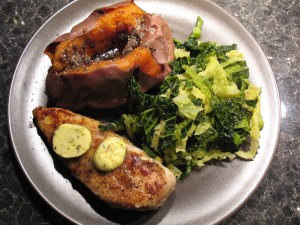
Sautéed chicken breast with lime-thyme butter, butter-braised cabbage and roast sweet potato with brown sugar and black pepper
I’ve intentionally not included measurements so you can feel free to experiment and play with the recipes.
Sautéed Chicken Breasts
Boneless, skinless chicken breasts
Salt and pepper
Flour
Butter
Oil
Pour some flour onto a plate. About 1/4 cup is good for four breasts. Rinse the chicken breasts and pat dry thoroughly with paper towels. It’s important they be completely dry. Sprinkle both sides of each breast with salt and pepper. Be generous. Press both sides of each breast into the flour. You can leave each on the plate as you go or set it aside.
Heat some butter and oil in a skillet over medium-high heat. Swirl the butter in the skillet as it heats. After the foaming subsides shake the chicken breasts to rid them of the excess flour and lay them in the skillet, tenderloin side down.
Sauté the chicken until browned on one side, about four minutes. The fat should be sizzling but not burning. Turn with tongs and sauté another four to five minutes. The chicken should be firm to the touch and nicely browned. Remove to plates and top with slices of lime-thyme butter.
Notes
- The flour is important here because it prevents the outside of the chicken from getting hard. It also helps with browning.
- Use any oil you like: olive, rapeseed, vegetable, what-have-you.
- Use all oil instead of butter, but the chicken won’t brown as well.
- Instead of the thyme-lime butter, swirl the fat in the pan with these combinations and pour over the chicken
- Capers, lemon juice and parsley
- Chopped olives, lemon juice, thyme and chile flakes
- Chopped tomatoes (fresh or sundried) and basil
- Minced garlic, cilantro (fresh coriander) and lime juice
Lime-thyme Compound Butter
Unsalted butter, softened
Fresh thyme, minced
Lime
Salt
Microwave the butter in a bowl for 10-20 seconds to soften, if necessary. Don’t let it melt. Stir in the thyme, zest, a bit of juice and a pinch of salt. Spoon onto one end of some cling film. Lift the end of the cling film and use it to roll the butter into a log. Wrap the butter log in the film and refrigerate until firm.
Notes
- You can top all manner of things with a compound butter: poached or sautéed fish, steaks, pork chops.
- Instead of lime use lemon or orange
- Instead of thyme use parsley, cilantro, dill or fennel fronds
Butter-braised Cabbage
Cabbage
Butter
Salt and pepper
Chicken stock
Cut the cabbage into quarters lengthwise and cut out the core. If the cabbage is large cut the quarters in half again. Cut crosswise into fine shreds. Rinse in a colander but don’t shake the water off.
Melt the butter in a sauté pan (a frying pan with straight sides) or dutch oven over medium heat. Add the cabbage and salt and pepper to taste, stir and cover. Cook until tender, about ten minutes, stirring occasionally and finish with a few spoons of chicken stock.
Notes
- If you don’t have chicken stock handy use a bit of boullion powder and water. I love a product called Better Then Boullion but I don’t think it’s available in Europe. Marigold Boullion is a great vegetarian option.
- Savoy cabbage is great but any will do. Green or white cabbage will take longer to cook and sweetheart or york cabbage will take less time.
Baked Sweet Potatoes with Brown Sugar and Black Pepper
(Inspired by Saveur Magazine)
Sweet potatoes (large ones)
Unsalted butter
Dark brown sugar
Fresh-ground black pepper
Kosher or flakes sea salt
Heat oven to 425F, 220C, gas mark 7. Place sweet potatoes on a foil-lined baking sheet and bake until soft, about 1 hour and 15 minutes. Remove potatoes from oven and allow to cool for 10 minutes. Split potatoes open and put a knob of butter and spoon of sugar into each potato. Season liberally (seriously, go nuts here, and I forbid you to use pre-ground) with black pepper. Finish with salt to taste.
Notes
- Please, please use freshly-ground black pepper.
Recent Comments
- Sophie Homeyer on ‘nduja like sobrassada?
- Peggy Gunter on Love in the Time of Carbohydrates
- Sharon on First thing: Lingering at the Table
- mary on First thing: Lingering at the Table
- Sharon on First thing: Lingering at the Table
Bill’s Tweets
- The RSS feed for this twitter account is not loadable for the moment.
Follow @tulanian on twitter.
Sharon’s Tweets
- The RSS feed for this twitter account is not loadable for the moment.
Follow @slgunter on twitter.
Tags
5yearson apple Asian beer Bill Cooks cabbage chickpeas dining dinner dublin dublinmoment farm fish food France Germany healthy holiday ireland kerry London mackerel mardi gras music pork potd quick from scratch rainbow recipe salad slovenia Slow Food snow snow peas SomethingAwesome Spain St. Anne's St. Stephen's Green table quiz thanksgiving tofu travel urban winter xmasArchives
- March 2021
- August 2020
- February 2015
- December 2014
- August 2014
- March 2014
- July 2013
- March 2013
- February 2013
- November 2012
- September 2012
- August 2012
- July 2012
- June 2012
- May 2012
- April 2012
- February 2012
- January 2012
- December 2011
- November 2011
- October 2011
- September 2011
- August 2011
- July 2011
- June 2011
- May 2011
- April 2011
- March 2011
- February 2011
- January 2011
- December 2010
- November 2010
- October 2010
- September 2010
- August 2010
- July 2010
- May 2010
- April 2010
- March 2010
- February 2010
- January 2010
- December 2009
- November 2009
- October 2009
- September 2009
- August 2009
- July 2009
- June 2009
- May 2009
- April 2009
- March 2009
- February 2009
- January 2009
- December 2008
- November 2008
- October 2008
- September 2008
- August 2008
- July 2008
- June 2008
- May 2008
- April 2008
- March 2008
- February 2008
- January 2008
- December 2007
- November 2007
- October 2007
- September 2007
- August 2007
- July 2007


